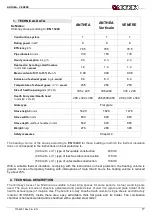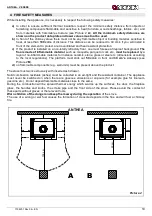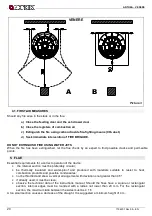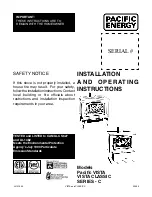
ANTHEA – VENERE
24
7194201 Rev.06 – EN
8. AIR ENTRANCE INTO THE INSTALLATION PLACE DURING THE COMBUSTION
As the stoves take their combustion air from the installation place, it is essential that a sufficient quantity of air
is introduced in the installation room itself.
In case of tight doors and windows (for example houses built according to the energy saving criteria) it is
possible that the air entrance is not guaranteed, compromising the draught, the welfare and the security of the
people. It is necessary to guarantee a further air entrance through a external air intake, to be positioned in the
nearby of the appliance or through air connection towards outside or a near ventilated room, with the
exception of thermal units place or garages (FORBIDDEN).
The air entrance for combustion into the installation place must not be closed during the operation of the stove
.
It is absolutely necessary that in the environment in which the stoves operate with the natural flue of the
chimney, it is introduced as much air as necessary for the combustion, i.e. up to 20 m
3
/hour.
The natural recirculation of air must be ensured by some fixed openings on the outside. The size of the
necessary openings for air is fixed by the relevant prescriptions. Ask information to your chimney sweeper.
The openings should be protected with grids and should never be obstructed.
An extraction hood (aspirating) installed in the same room or in a room nearby, causes depression with output
of combusted gasses (smoke, smell). As consequence it is necessary to ensure more flow of fresh air.
The depression in an extraction hood can at worst hypothesis, transforms the flue into an external air
intake, by sucking the smokes of the rooms with dangerous consequences for the people.
9.
LIGHTING
IMPORTANT: the first time that the appliance is lit, there will be an odour given off (due to the drying of the
adhesives of the junction chord), which disappears after a short use. It must be ensured, in any case, a
good ventilation of the environment. Upon the first ignition we suggest loading a reduced quantity of
fuel and slightly increasing the calorific value of the equipment.
To perform a correct first lighting of the products treated with paints for high temperature, it is necessary to
know the following information:
•
the construction materials of the involved products are not homogeneous, as matter of fact there are
simultaneously parts in cast iron, steel, refractory material and majolica;
•
the temperature to which the body of the product is subject is not homogeneous: from area to area,
variable temperatures within the range of 300°C - 5 00 °C are detected;
•
during its life, the product is subject to alternated lighting and extinguishing cycles in the same day, as
well as to cycles of intense use or of absolute standstill when season changes;
•
the new appliance, before being considered seasoned has to be subject to many start cycles to allow
all materials and paints to complete the various elastic stresses;
•
in detail, initially it is possible to remark the emission of smells typical of metals subject to great thermal
stress, as well as of wet paint. This paint, although during the manufacture it is backed at 250 °C fo r
some hours, must exceed many times and for a given period of time the temperature of 350 °C before
becoming completely embedded in the metallic surfaces.
Therefore, it is extremely relevant to take these easy steps during the lighting:
1) Make sure that a strong air change is assured in the room where the appliance is installed.
2) During the first starts, do not load excessively the combustion chamber (about half the quantity
indicated in the instructions manual) and keep the product continuously ON for at least 6-10 hours with
the registers less open than the value indicated in the instructions manual.
3) Repeat this operation for at least 4-5 or more times, according to your possibilities.
4) Then load more and more fuel (following in any case the provisions contained in the installation booklet
concerning maximum load) and, if possible, keep the lighting periods long avoiding, at least in this
initial phase, short ON/OFF cycles.
5) During the first starts, no object should be leaned on the appliance and in detail on enamelled
surfaces. Enamelled surfaces must not be touched during heating.
6)
Once the «break-in» has been completed, it is possible to use the product as the motor of a car,
avoiding abrupt heating with excessive loads.
To light the fire, it is suggested to use small wood pieces together with paper or other traded lighting means. It
is FORBIDDEN to use any liquid substance as for ex. alcohol, gasoline, oil and similar.
Summary of Contents for ANTHEA
Page 2: ...ANTHEA VENERE 2 7194201 Rev 06 IT EN DE FR...
Page 53: ...ANTHEA VENERE 7194201 Rev 06 IT EN DE FR 53...
Page 54: ...ANTHEA VENERE 54 7194201 Rev 06 IT EN DE FR...
Page 55: ...ANTHEA VENERE 7194201 Rev 06 IT EN DE FR 55...
Page 56: ...ANTHEA VENERE 56 7194201 Rev 06 IT EN DE FR 10 x 10 x...
Page 57: ...ANTHEA VENERE 7194201 Rev 06 IT EN DE FR 57...
Page 59: ...ANTHEA VENERE 7194201 Rev 06 IT EN DE FR 59...
Page 60: ...ANTHEA VENERE 60 7194201 Rev 06 IT EN DE FR...
Page 61: ...ANTHEA VENERE 7194201 Rev 06 IT EN DE FR 61...
Page 62: ...ANTHEA VENERE 62 7194201 Rev 06 IT EN DE FR...
Page 64: ...ANTHEA VENERE 64 7194201 Rev 06 IT EN DE FR ANTHEA Verticale...
Page 65: ...ANTHEA VENERE 7194201 Rev 06 IT EN DE FR 65 VENERE...
















































